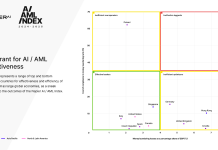As more and more people rely on cashless systems to move money around, there is a pressing need to understand how electronic funds transfers (EFTs) – specifically – wire transfers and automated clearing house (ACH) transfers – could be at risk from financial crime.
Alessa, by Tier1 Financial Solutions recently released a blog post that focused on the differences between the two kinds of EFTs to provide compliance professionals with a better idea between the two.
Wire transfers commonly involve a transfer of funds done electronically amongst a network of banks or transfer agencies worldwide, with senders paying for the transaction at the remitting bank and providing the name, bank account number and amount transferred to the bank.
Meanwhile, ACH transfers involve the movement of money between banks through the ACH network and include person-to-person payments, bill payments and direct deposits from employers and government benefit programs.
According to Alessa, by Tier1 Financial Solutions, any form of EFT that allows rapid funds movement, especially across borders, presents a higher potential risk for money laundering.
The post stated, “Wire transfers have historically been the tool of choice for money launderers, given their irrevocability and rapid funds availability. Anti-money laundering regulations in the US and other countries specifically target wire transfers by requiring financial institutions to include certain information on the transaction record about the originator, beneficiary, and the financial institutions involved.
“ACH transfers were originally designed for batch processing of high volume, low-dollar domestic transactions (primarily consumer payments) which are relatively low risk from a money laundering perspective. Over the years, this original purpose has now expanded with the intent to compete with traditional wire transfers. For example, same day ACH, with its steadily increasing transaction dollar limit (soon to be $1 million per transaction in early 2022) offers a much lower cost alternative to a wire transfer.”
The company highlighted that ACH transactions can be much more appealing to money launderers compared to wire transfers, as a domestic ACH transaction record has very limited information about the payment’s originator and receiver. Furthermore, ACH’s may be used to legitimise frequent and recurring transactions – therefore they may be less noticeable to the transaction monitoring systems of banks.
While domestic ACH transactions may be more riskier against money launderings, the firm remarked that cross-border ACH transfers provide a further layer of safety that can protect against financial crime.
Previously similar to its domestic counterparts in terms of information requirements, pressure on the US’ National Automated Clearing House Association (NACHA) by the U.S Office of Foreign Assets Control and on the U.S anti-money laundering regulatory regime of the Financial Actions Task Force led to the creation of International ACH transaction (IAT).
Alessa, by Tier1 Financial Solutions said, “IATs must include all information about the originator and receiver as is required for wire transfers pursuant to Bank Secrecy Act regulations as well as additional information not considered mandatory by these regulations – such as the purpose of the payment, the receiver’s full address, and a distinct field for the destination’s ISO country code. As a result, financial institutions may now easily identify, segregate, and OFAC screen cross-border ACH payments as they have always done for wire transfers.”
Wire, ACH usage
The company went on to highlight that both wire transfers and ACH credits/debits are used extensively by fraudsters in ‘social engineering’ schemes, which commonly convince the victim of a fraud to send funds to a third party that they are told is legitimate and important.
However, the firm noted wire transfers still hold the most appeal for fraudsters due to their immediacy and irrevocability. In addition, depending on the time of day an ACH transfer is requested, it could still be deleted from a pending ACH batch prior to transmission to the ACH Network – providing just enough time for a victim to think twice about sending the transaction.
The business said in the blog post, “Fraudsters have been known to partner with a colluding ACH third-party service provider in scams targeting the elderly. These scams typically involve ACH debits to the victims’ accounts for services that are never actually provided, or the fraudsters may impersonate a government or healthcare organization and convince the victim they must authorize the ACH debits.
“Because the third-party service provider (TPSP) is the entity with the ACH processing and account relationship with the financial institution, the fraudsters are shielded from the bank’s customer due diligence and transaction monitoring. As well, a TPSP may process thousands of ACH transactions per day for hundreds of originators, making detection of any suspicious activity nearly impossible.”
The firm concluded by noting that compliance professionals must understand the key differences between the two forms of EFTs ‘in order to properly assess the risks these products pose for their own financial institutions’.
In addition, Alessa, by Tier1 Financial Solutions said it was less about the payment methods themselves, but rather how and when they are used by bad actors that is of ‘utmost importance’ in preventing and detecting financial crimes.
The full blog post can be viewed here.
Copyright © 2021 FinTech Global











